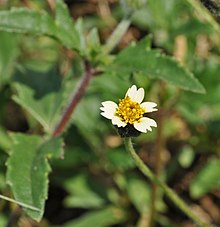bio.wikisort.org - Plant
Tridax procumbens, commonly known as coatbuttons[1] or tridax daisy, is a species of flowering plant in the family Asteraceae. It is best known as a widespread weed and pest plant. It is native to the tropical Americas, but it has been introduced to tropical, subtropical, and mild temperate regions worldwide. It is listed as a noxious weed in the United States and has pest status in nine states.[2]
Common names
Its common names include coatbuttons and tridax daisy in English, jayanthi(ಜಯoತಿ) in Kannada, cadillo chisaca in Spanish, herbe caille in French, jayanti veda (जयंती वेद) and "Avanti"[3] in Sanskrit,"Ghajadvu" in Gujarati "Kumminnippacha", (കുമ്മിനിന്നിപാച്ച) "Kurikootticheera",(കുറികോട്ടിച്ചിചിറ) "Muriyampachila" (മുരിയമ്പാചില), "Odiyancheera", (ഒഡിയൻചിറ) "Railpoochedi, (റൈലാപൂച്ചെഡി) "Sanipoovu",(ഷാനിപോവ്) "Thelkuthi", (തെക്കുത്തി) "Chiravanakku", (ചിരവനാക്ക്) in Malayalam, bikhalyakarani in Assamese, ghamra in Hindi, Tridhara (ত্রিধারা) in Bengali, bishalya karani (ବିଶଲ୍ୟକରଣୀ) in Oriya, kambarmodi, Jakhamjudi & tantani (कंबरमोडी, जखमजुडी & टनटनी) in Marathi, gayapaaku (గాయపాకు) & gaddi chemanthi (గడ్డి చామంతి) & balapaaku (బలపాకు) in Telugu,vettukaaya poondu or thatha poo or kinatruppasan (கிணற்றுப்பாசான்) in Tamil, Ghaburi (ઘાબુરી) in Gujarati[4] kotobukigiku in Japanese and tīn túkkæ (ตีนตุ๊กแก; 'gecko feet') in Thai.[5] in Urdu it is known as zagh mai hayat.
Description

The plant bears daisylike yellow-centered white or yellow flowers with three-toothed ray florets. The leaves are toothed and generally arrowhead-shaped. Its fruit is a hard achene covered with stiff hairs and having a feathery, plumelike white pappus at one end. Calyx is represented by scales or reduced to pappus. The plant is invasive in part because it produces so many of these achenes, up to 1500 per plant, and each achene can catch the wind in its pappus and be carried some distance. This plant can be found in fields, meadows, croplands, disturbed areas, lawns, and roadsides in areas with tropical or semi-tropical climates.[citation needed] It is listed in the United States as a Noxious Weed and regulated under the Federal Noxious Weed Act.[citation needed]

Use in traditional medicine
Traditionally, Tridax procumbens has been in use in India for wound healing and as an anticoagulant, antifungal, and insect repellent.[citation needed] Tridax procumbens is also used as treatment for boils, blisters, and cuts by local healers in parts of India.[6]
Chemical constituents
The flavonoid procumbenetin has been isolated from the aerial parts of Tridax procumbens. Other chemical compounds isolated from the plant include alkyl esters, sterols,[7] pentacyclic triterpenes,[7][8] fatty acids,[9] and polysaccharides.[10] Several main active chemical compounds were found to be present. But toxicological knowledge is scarce and more research described to be needed on this plant.[11]
Gallery
- Flower bud and leaves of Tridax procumbens
- Ripe fruit with winged achenes ready for wind-dispersal.
- Residual fruit after achene dispersal.
- Crimson Tip Colotis danae in Hyderabad, India. Coat buttons are widely visited by butterflies.
- Danaus chrysippus feeding on Tridax procumbens in Bandung West Java, Indonesia.
- Exoskeleton of cicada clinging to Tridax procumbens stem.
- Flower in Hyderabad, India
- Wasp feeding the nectar of Tridax procumbens
- Ripe fruit with winged achenes
References
- USDA, NRCS (n.d.). "Tridax procumbens". The PLANTS Database (plants.usda.gov). Greensboro, North Carolina: National Plant Data Team. Retrieved 15 December 2015.
- "Tridax procumbens L." at the Encyclopedia of Life
- Ambulkar, Pranit (2012). "Avanti"- Tridax procumbens Linn The new healing herb of Ayurveda (1. Aufl ed.). Saarbrücken: LAP. ISBN 9783659243851.
- Saxena, V. K.; Albert, Sosanna (2005). "Β-Sitosterol-3-O-β-D-xylopyranoside from the flowers of Tridax procumbens Linn". Journal of Chemical Sciences. 117 (3): 263–6. doi:10.1007/BF02709296.
- "ตีนตุ๊กแก" (in Thai). qsbg. Retrieved August 1, 2016.
- Nallella, Sreeramulu; Suthari, Sateesh; Ragan, A; Raju, Vatsavaya S (2013). "Ethno-botanico-medicine for common human ailments in Nalgonda and Warangal districts of Telangana, Andhra Pradesh, India". Annals of Plant Sciences. 2 (7): 220–9.
- Gamboa-Leon, Rubi; Vera-Ku, Marina; Peraza-Sanchez, Sergio R.; Ku-Chulim, Carlos; Horta-Baas, Aurelio; Rosado-Vallado, Miguel (2014). "Antileishmanial activity of a mixture of Tridax procumbensand Allium sativumin mice". Parasite. 21: 15. doi:10.1051/parasite/2014016. PMC 3980668. PMID 24717526.
- Petchi, Rramesh; Vijaya, C; Parasuraman, S (2013). "Anti-arthritic activity of ethanolic extract of Tridax procumbens (Linn.) in Sprague Dawley rats". Pharmacognosy Research. 5 (2): 113–7. doi:10.4103/0974-8490.110541. PMC 3685759. PMID 23798886.
- Ali, Mohammed; Ravinder, Earla; Ramachandram, Ramidi (2001). "A new flavonoid from the aerial parts of Tridax procumbens". Fitoterapia. 72 (3): 313–5. doi:10.1016/S0367-326X(00)00296-3. PMID 11295316.
- Pathak, A.K; Saraf, S; Dixit, VK (1991). "Hair growth promoting activity of Tridax procumbens". Fitoterapia. 62: 307–13.
- Ingole, Varsharani V.; Mhaske, Pravin C.; Katade, Sushma R. (2021-12-13). "Phytochemistry and Pharmacological aspects of Tridax procumbens (L.): A Systematic and Comprehensive Review". Phytomedicine Plus: 100199. doi:10.1016/j.phyplu.2021.100199. ISSN 2667-0313.
Further reading
- Everitt, J.H.; Lonard, R.L.; Little, C.R. (2007). Weeds in South Texas and Northern Mexico. Lubbock: Texas Tech University Press. ISBN 978-0896726147.
External links
![]() Media related to Tridax procumbens at Wikimedia Commons
Media related to Tridax procumbens at Wikimedia Commons
- PIER fact sheet
- invasive.org profile
- Photo gallery
- Tridax procumbens in West African plants – A Photo Guide.
На других языках
- [en] Tridax procumbens
[es] Tridax procumbens
Tridax procumbens es una planta medicinal perteneciente a la familia de las asteráceas[1] Conocida también en Guatemala como: bakenbox, cadillo, chisaaca, curagusano, hierba de San Juan, romerillo, San Juan del monte.[2]Другой контент может иметь иную лицензию. Перед использованием материалов сайта WikiSort.org внимательно изучите правила лицензирования конкретных элементов наполнения сайта.
WikiSort.org - проект по пересортировке и дополнению контента Википедии









